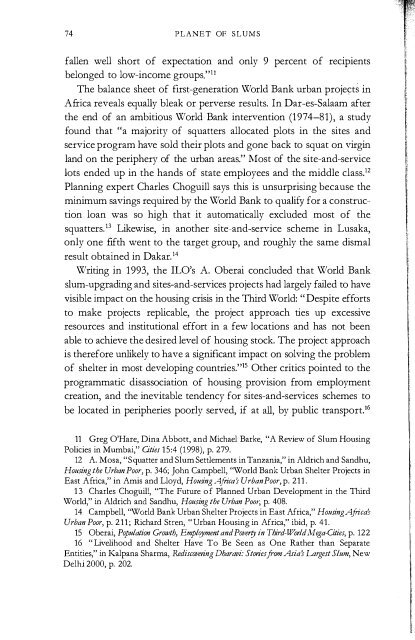Untitled - Rebel Studies Library
Untitled - Rebel Studies Library
Untitled - Rebel Studies Library
Create successful ePaper yourself
Turn your PDF publications into a flip-book with our unique Google optimized e-Paper software.
74 PLANET OF SLUMS<br />
fallen well short of expectation and only 9 percent of recipients<br />
belonged to low-income groups."! !<br />
The balance sheet of first-generation World Bank urban projects in<br />
Africa reveals equally bleak or perverse results. In Dar-es-Salaam after<br />
the end of an ambitious World Bank intervention (1974-81), a study<br />
found that "a majority of squatters allocated plots in the sites and<br />
service program have sold their plots and gone back to squat on virgin<br />
land on the periphery of the urban areas." Most of the site-and-service<br />
lots ended up in the hands of state employees and the middle class.!2<br />
Planning expert Charles Choguill says this is unsurprising because the<br />
minimum savings required by the World Bank to qualify for a construction<br />
loan was so high that it automatically excluded most of the<br />
squatters.13 Likewise, in another site-and-service scheme in Lusaka,<br />
only one fifth went to the target group, and roughly the same dismal<br />
result obtained in Dakar.!4<br />
Writing in 1993, the ILO's A. Oberai concluded that World Bank<br />
slum-upgrading and sites-and-services projects had largely failed to have<br />
visible impact on the housing crisis in the Third World: "Despite efforts<br />
to make projects replicable, the project approach ties up excessive<br />
resources and institutional effort in a few locations and has not been<br />
able to achieve the desired level of housing stock. The project approach<br />
is therefore unlikely to have a significant impact on solving the problem<br />
of shelter in most developing countries."!5 Other critics pointed to the<br />
programmatic disassociation of housing provision from employment<br />
creation, and the inevitable tendency for sites-and-services schemes to<br />
be located in peripheries poorly served, if at all, by public transport.!6<br />
11 Greg O'Hare, Dina Abbott, and Michael Barke, "A Review of Slum Housing<br />
Policies in Mumbai," Cities 15:4 (1998), p. 279.<br />
12 A. Mosa, "Squatter and Slum Settlements in Tanzania," in Aldrich and Sandhu,<br />
Housing the Urban Poor, p. 346; John Campbell, "World Bank Urban Shelter Projects in<br />
East Africa," in Amis and Lloyd, Housing Afn·ca 's Urban Poor, p. 211.<br />
13 Charles Choguill, "The Future of Planned Urban Development in the Third<br />
World," in Aldrich and Sandhu, Housing the Urban POOt; p. 408.<br />
14 Campbell, "World Bank Urban Shelter Projects in East Africa," HousingAfrica's<br />
Urban Poor, p. 211; Richard Stren, "Urban Housing in Africa," ibid, p. 41.<br />
15 Oberai, Population Growth, Employment and Poverry in Third-World Mega-Cities, p. 122<br />
16 "Livelihood and Shelter Have To Be Seen as One Rather than Separate<br />
Entities," in Kalpana Sharma, Rediscovering Dharavi: Stoties from Asia's Largest Slum, New<br />
Delhi 2000, p. 202.<br />
ILLUSIONS OF SELF-HELP 75<br />
Yet the Bank continued to press its incrementalist approach - now<br />
refurbished and renamed "whole-sector housing development" - as the<br />
best strategy to ameliorate slum conditions.<br />
Soft Imperialism<br />
Since the mid-1990s the World Bank, the United Nations Development<br />
Program, and other aid institutions have increasingly bypassed or<br />
short-circuited governments to work directly with regional and neigh<br />
borhood non-governmental organizations (NGOs). Indeed, the NGO<br />
revolution - there are now tens of thousands in Third World cities -<br />
has reshaped the landscape of urban development aid in much the<br />
same way that the War on Poverty in the 1960s transformed relations<br />
between Washington, big city political machines, and insurgent inner<br />
city constituenciesY As the intermediary role of the state has declined,<br />
the big international institutions have acquired their own grassroots<br />
presence through dependent NGOs in thousands of slums and poor<br />
urban communities. Typically, an international lender-donor like the - '<br />
\Vorld Bank, the UK Department for International Development, the<br />
Ford Foundation, or the German Friedrich Ebert Foundation will work<br />
through a major NGO which, in turn, provides expertise to a local<br />
NGO or indigenous recipient. This tiered system of coordination and<br />
funding is usually portrayed as the last word in "empowerment,"<br />
"synergy," and "participatory governance."<br />
On the World Bank side, the increased role of NGOs corresponded<br />
to the reorientati n of Bank objectives under the presidency of James<br />
Wolfensohn, the Australian-born financier and philanthropist whose<br />
decade in office began in June 1995. Wolfensohn, according to biographer<br />
Sebastian Mallaby, arrived in Washington as a self-proclaimed<br />
world-fixer, "seeking to revive the messianic energy of McNamara's<br />
Bank" by making poverty reduction and "partnership" the new centerpieces<br />
of his agenda. Third World governments were required to<br />
involve NGOs and advocacy groups in the preparation of the Poverty<br />
Reduction Strategy Papers (PRSP) that the Bank now required as proof<br />
that aid would actually reach target groups. In a cooptive McNamaran<br />
17 Datta and Jones, "Preface," p. xviii.


